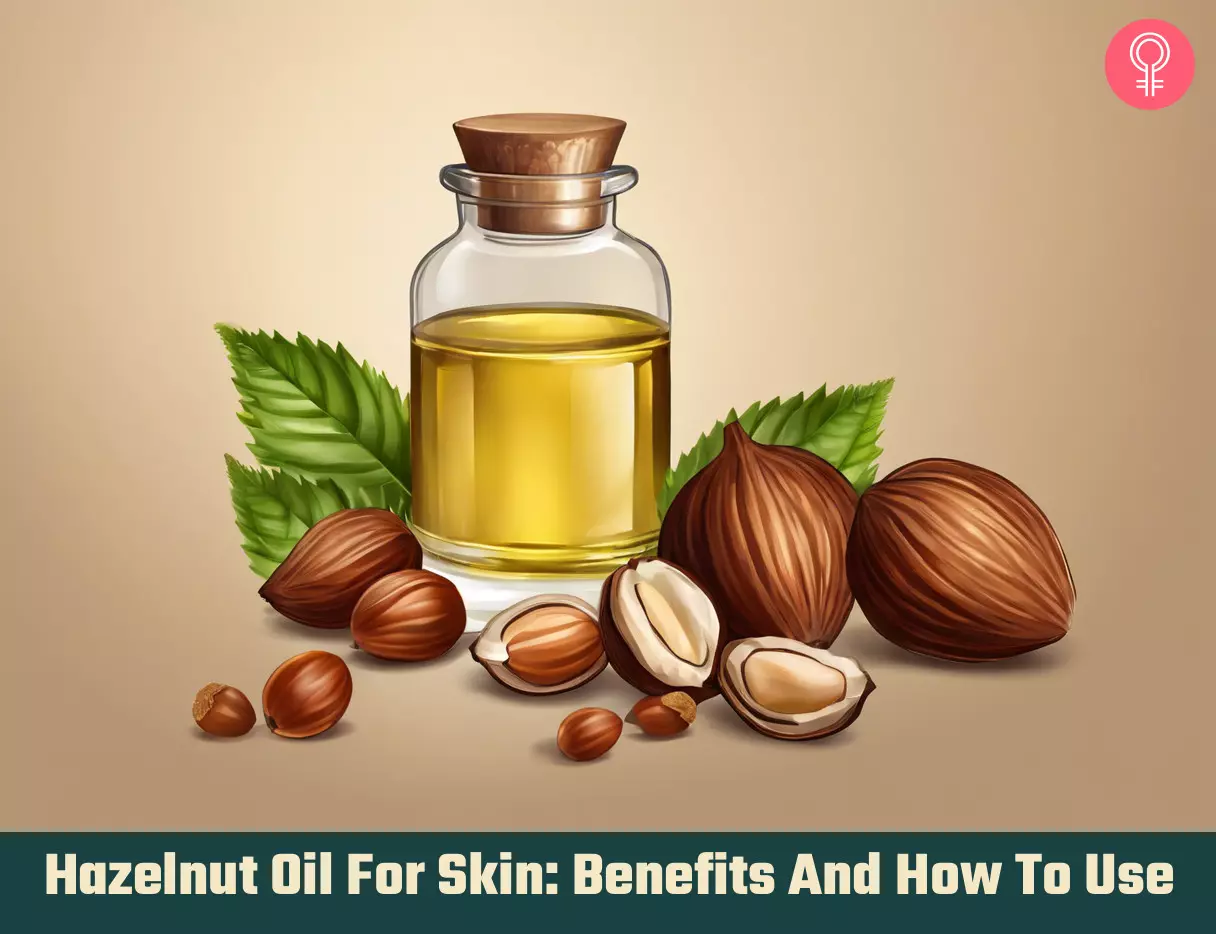What Is Hazelnut Oil?
Hazelnut oil is extracted from hazelnut kernels that contain about 60% oil (1). The oil is extracted by the cold press or solvent extraction methods. Although it is mainly popular in the food industry, it has been gaining traction in the cosmetic industry as well. It is a non-greasy oil known for its moisturizing properties. What Are Its Benefits? Moisturizes the skin and protects it from sun damage, helps reduce wrinkles and fine lines, treats acne, and boosts collagen production. Who Can Use It? All except those who are allergic to tree nuts. How Often? Daily or as prescribed. Caution Individuals allergic to nuts and pollen should avoid using it. Perform a patch test if you have sensitive skin.
Hazelnut Nutrition Composition And Benefits
Hazelnut contains many nutrients beneficial to skincare, like fatty acids, vitamins, minerals, squalene, and tocopherols (1), (3), ( 4).
Fatty acids play a role in balancing the skin’s protective barrier (5). They also prevent the loss of moisture from the skin’s surface. These fatty acids prevent any harmful substances from entering the skin. Vitamin C (ascorbic acid) prevents and repairs photo-aging. It has antioxidant properties that protect the skin from UV damage (6), (7) (8). It can also be used to help reduce hyperpigmentation. Vitamin C has anti-inflammatory properties and can help treat skin conditions like acne and rosacea. It also promotes wound healing and boosts collagen synthesis. Vitamin E contains tocopherols and tocotrienols. It has high antioxidant properties that reduce free radical damage due to solar radiation (9). It protects the skin from oxidative stress. It may help prevent sun damage from a sunburn. It has therapeutic effects against psoriasis, acne, sclerodermai A group of rare diseases that lead to the hardening and tightening of the skin in middle-aged women. , and atopic dermatitisi An allergic reaction to certain products or environmental factors that leads to dry and inflamed skin. . It can also promote wound healing. It might reduce the signs of sun damage, including skin thickening, wrinkling, and erythemai A skin condition that causes inflammation triggered by an infection or a reaction to certain medicines. (10). Tocopherols also have skin-conditioning properties (11). Folic acid improves skin firmness that may otherwise deteriorate due to aging (12). Folic acid supplementation is often used to treat chronic inflammatory skin conditions (13). Vitamin A (retinol) is often used in the treatment of acne, psoriasis, and other skin conditions (14). It also slows down the aging process. It protects the skin barrier functions and collagen, and reduces water loss. It also prevents the discoloration of the skin. It reduces excess sebum production, improves skin elasticity, and boosts collagen synthesis and keratin formation. It reduces the signs of aging and photoagingi Premature aging of skin due to sun exposure that increases risk of wrinkles, pigmentation, loss of skin tone, or even skin cancer. too (15). Research shows that vitamin A can reduce fine lines and wrinkles effectively (16). Niacin improves the skin barrier function (14). It prevents water loss and increases the moisture content in the skin. It improves skin quality and reduces wrinkles. It may help treat skin conditions like acne and rosacea, thanks to its anti-inflammatory properties. It reduces the effects of aging and might also reduce skin discoloration. Minerals like zinc and copper offer photoprotective properties and prevent damage from UV radiation (15). These minerals prevent the radiation from penetrating the skin. They also have antioxidant properties. Copper, additionally, improves skin elasticity and thickness.
Table 1: Nutrient composition of 100gms of Hazelnuts (3)
Abbreviations: SFA, saturated fatty acids; MUFA, monounsaturated fatty acids; PUFA, polyunsaturated fatty acids; LA, linoleic acid; ALA, α-linolenic acid
Table 2: Nutrient Composition Of Hazelnuts (1)
Table 3: Vitamin Composition in Hazelnut (4)
Table 4: Mineral Composition in Hazelnut (4)
Here are some additional benefits of Hazelnut oil for skin. Palmitoleic acid (0.1-0.3) Stearic acid (0.4-3.8) Oleic acid (76.3-86.5) Linoleic acid (6.5-15.6) Linolenic acid (0.1-1.9) Arachidic acid (0-0.2) OLLn – 0.5 OLLn – 12.3 OLnO – 0.7 LLP – 1.6 OLO – 28.2 LOP – 5.2 PLP – 0.2 OOO – 36.5 SLO – 1.4 OOP – 6.1 SOO – 2.8 Campesterol (4.8-7.4) Campestanol (0-0.2) Stigmasterol (1.3-2.1) Campesterol (0-0.4) Stigmastadienol + Clerosterol (0.9-1.3) 𝛽-Sitosterol (78.1-90.4) Sitostanol (1.8-3.6) Avenasterol (1.3-5.2) Stigmastadienol (0.3-1.1) Stigmasterol (0.3-2.3) Avenasterol (0.5-1.9)
Benefits Of Hazelnut Oil For Skin
How To Use Hazelnut Oil For Skin
Note: Perform a patch test before applying hazelnut oil to your skin. Apply some of this natural oil to your forearm and wait for a few hours. Avoid use if you notice any adverse effects like redness, swelling, itching, rashes, inflammation, or burning sensations.
Hazelnut oil (regular and essential) can be used on its own or with other oils. Pair the oil with carrier oils or other essential oils to boost its medicinal and cosmetic benefits. The oil can also be paired with other organic ingredients and skin care products (since it is an emulsifier).
Procedure
You can buy the oil or even make it at home. Preparing hazelnut oil is simple. Read on to know more about the preparation process.
How To Make Hazelnut Oil
What You Need
50 g of hazelnuts 250 ml of sunflower oil A pan An empty container (300 ml)
How To Prepare
- Chop the hazelnut kernels into smaller pieces. 2. Toast them on the pan. Ensure you toast without any fat. 3. Once toasted, remove them from the pan. 4. Let them cool for about 20 minutes. 5. Pour the sunflower oil into a bowl. 6. Add the nuts to the oil and mix well. 7. Transfer the mixture to the container. 8. Close the jar tightly and store it in a dark place for 3 weeks. 9. After 3 weeks, strain the oil into an amber bottle and use within 2 weeks. As with most natural ingredients, hazelnut oil may cause certain side effects in some. Read on to know more.
Side Effects Of Hazelnut Oil
Hazelnut oil is generally considered safe for consumption and topical application. However, there is not enough research to guarantee its safety. In an unpublished study, hazelnut oil displayed no irritating effects on 20 patients who were prone to cosmetic contact allergy (29). It is advised to avoid hazelnut oil if you have any kind of nut allergy or sensitive skin. Hazelnut contains proteins similar to that of pollen allergens. If you have pollen allergies, hazelnut oil might not suit your skin. Perform a patch test on the back of your neck or under your forearm to ensure no harmful or adverse effects occur. Some adverse reactions that might occur on using hazelnut oil include:
Redness Burning sensations Discomfort Swelling Scaling Breakouts Acne or skin condition flare-ups
If you do feel any discomfort, inflammation or irritation, wash the oil and consult a dermatologist immediately. What does hazelnut oil smell like? Hazelnut oil has a mild, nutty, and sweet scent. How do you store hazelnut oil? You should store hazelnut oil in a cool place away from direct sunlight. Once opened, you can store hazelnut oil in the refrigerator. While the refrigeration may cause the oil to solidify, you can keep the oil out for one or two hours to bring it back to room temperature. Does hazelnut oil expire? Yes, hazelnut oil can only last between 9 to 12 months if properly stored.
Illustration: Hazelnut Oil For Skin: Benefits And How To Use












